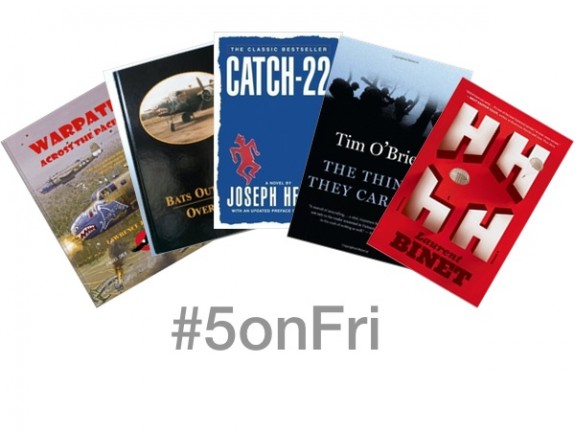Military history is often an underappreciated genre supposedly filled with stuffy biographies, or a litany of dates and battle names.
When I took on the project of writing Flying Colors, even I approached the genre with the same perspective. As I would with any new project, I began with exploring possibilities and took to reading. I had expected dusty volumes and tedious works.
Instead, I found a vibrant collection of memoirs, biographies, and research that read like adventure fiction or romance novels. After letting go of my presupposed notions of what a military history was supposed to be, I found myself engaging with my own book more deeply.
Flying Colors is a personal narrative of one bomber pilot’s fight during WWII in the South Pacific. His life was colorful and his personality large. I know this first hand from interviewing him and from reading his old letters. But translating it on to the page was proving difficult. So rather than slog through an ever-growing pile of notes and historical research, I allowed myself to write the book I wanted to read. Flying Colors was shaped not only by the research I had completed on the pilot, but also by the books I had read. These are a few of them that helped me find the form and voice I was struggling to capture.
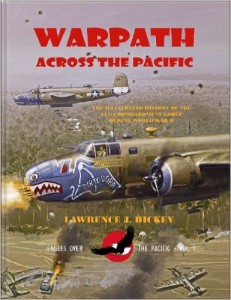 1) Warpath Across the Pacific
1) Warpath Across the Pacific
By: Lawrence J. Hickey
Warpath Across the Pacific is a broad scope narrative that tells the story of the 345th bombardment from the beginning of the war to the end of it. Hickey includes personal stories of several of the men as well as photographs and illustrations. Each story is told with a touch of nostalgia and pride. Rather than giving a stark report on the statistics of the battles, Hickey paints a vivid picture of each and every encounter. He includes research, eyewitness accounts, and lots of technical information regarding the missions and equipment. Every battle, skirmish, and close call is painstakingly detailed, and the level of research that went into this book is evident. This book was written with WWII enthusiasts in mind, but it is equally engrossing for those of us who are looking for the adventure.
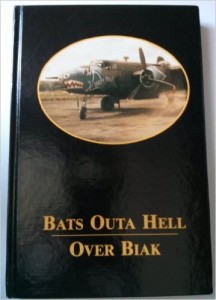 2) Bats Outta Hell Over Biak
2) Bats Outta Hell Over Biak
By: Max B. Ferguson
Bats Outta Hell is Ferguson’s personal story as part of the 499th bomber squadron, the Bats Outta Hell. They were a smaller squadron within the 345th. Like Warpath, Bats Outta Hell tells a story of the South Pacific during WWII. The difference however, is that Bats tells a more personal tale. It’s Ferguson’s memoir. With his personal story we get an even closer look into the day-to-day activities of a South Pacific bomber pilot. There were adventures, losses, and lots of dodged bullets, but there also was humor and friendship—all told in the first person.
He goes much further than just the battles. For instance, after a harrowing encounter including anti-aircraft guns and heavy artillery ripping through planes, the reader is offered a cold beer back on base where stories are shared with friends about other close calls. In tents, at the officers club, and in hotel rooms, the narrative of Bats Outta Hell Over Biak offers a real taste of what it was like for the men who flew and fought in the South Pacific, not only during the fighting but also in the quiet times in-between.
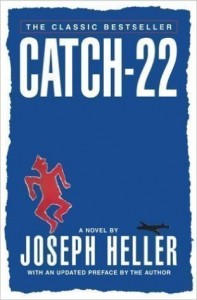 3) Catch 22
3) Catch 22
By: Joseph Heller
Catch 22 is a work of fiction. But it’s a work of fiction based on the realities of what enlisted men and pilots experienced during WWII in Europe. This book tells the story of a field base camp. The narrative never actually leaves the camp, and the men passing through bring their own tragic stories with them. They swap stories, joke about past events, and bemoan the number of missions they have left before they can be discharged from service. The characters are distinctive and range in personalities from the apathetic base commander who avoids his men and shirks responsibility, to the ineffective pastor who tries rather pathetically to save the men’s souls as well as his own sanity. The primary character is Captain John Yossarian. He is shaken by events and hides in the woods naked for days after his friend, Snowden, dies gruesomely in his arms.
This book is full of vivid and startling characters who bring multiple lives and deaths into one cohesive narrative that serves to bring into sharp focus that “War is Hell.” The characters in this book are so human the reader can easily forget this is a work of fiction.
 4) The Things They Carried
4) The Things They Carried
By: Tim O’Brien
The Things They Carried is a work of fiction based on O’Brien’s experiences as a soldier in Vietnam. The narrative relies on short stories to tell the truth of experience, rather than fact, and refrains from political or social debate and commentary. The jaded tone of the soldiers portrayed, however, conveys a disconnect between the experience of the platoon members and the greater political aims of the war.
O’Brien tells the story of an entire platoon by sharing snippets of each platoon member’s own personal narratives. There are lots of other contrasts too. For instance the silly good luck charm of a girlfriend’s pantyhose emphasizes the men’s romanticism and superstition while they are left facing the grim reality of death day after day. Men pop in and out of the narrative, sometimes reappearing later in the book, while others die in ways only war allows. Reading this book elicits emotions that range from humor, to shock, and disgust. O’Brien does something powerful in “Things.” He brings home to the reader what it was like in Vietnam, not only the bad, but the odd, the humorous, and the everyday slog.
 5) HHH
5) HHH
By: Laurent Binet
HHH is perhaps my favorite book on this list. This is because it is a work of fiction using the non-fiction writers’ toolbox. It’s complicated, captivating, and adventurous. Binet did copious amounts of research to write this fictional account of SS General Reinhard Heydrich. Every event in this book actually happened. The only thing that marks it as fiction is the inventing of dialogue and how the scenes are portrayed. Binet painstakingly details Heydirch’s last days, and the course of events that led to his demise.
The story is told through the voice of a nameless narrator, Binet. He is researching Heydrich, and wants to write the man’s story. But the narrator cannot release himself to full creative invention as he is held captive to his schooling in fact-based writing. As he researches and learns more about Heydrich, his imagination fills in the gaps his research has been unable to fill. What happens is the telling of a true story told as fiction alongside another true story of discovering the original. It’s easy to get caught up in the writer’s frustration and obsession. It’s equally as easy to get caught up in the tension of Heydrich’s narrative. Reading this book asked a lot of questions in its search for the truth.
…………..

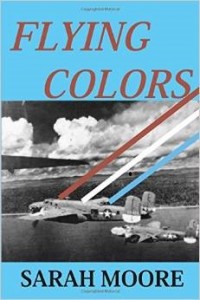 Sarah Moore is the author of the recently published FLYING COLORS. She also is a mother, writer, adventurer, sailor, backpacker, and avid splasher of puddles. Her work has appeared in Maine Boats Homes and Harbors, Adventure Hats, The Sandy River Review, Word Legs, and Doire Press. She writes about life and all the strange and exciting places it can take us. From the most mundane experiences of drinking a cup of coffee with friends, to flying a B-25 bomber over enemy held territory.
Sarah Moore is the author of the recently published FLYING COLORS. She also is a mother, writer, adventurer, sailor, backpacker, and avid splasher of puddles. Her work has appeared in Maine Boats Homes and Harbors, Adventure Hats, The Sandy River Review, Word Legs, and Doire Press. She writes about life and all the strange and exciting places it can take us. From the most mundane experiences of drinking a cup of coffee with friends, to flying a B-25 bomber over enemy held territory.
She earned her BFA in Creative Writing from the University of Maine, Farmington, and holds an MA in writing from the National University of Ireland. She currently lives with her family in Augusta, Maine, where she often is found poking around historic sites for story ideas or traipsing around outside looking for adventure. Other books by Moore include Broken Bones and River Stones, and My World in Words.



